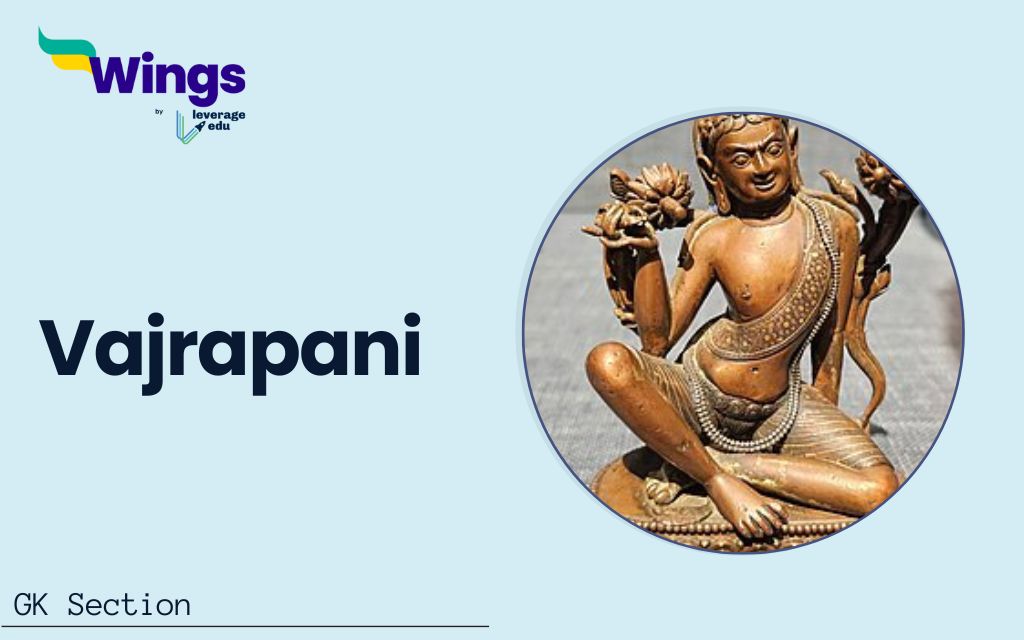One of the earliest bodhisattvas to appear in Mahayana Buddhism was Vajrapani. He is the advisor and protector of Gautama Buddha, and the rose is a symbol of the Buddha’s might. As the protector of Buddha, Vajrapani stands for the strength of Buddhahood and all Buddhas. As a result of carrying the Vajra, or thunderbolt, in his right hand, he is also referred to as Vajrapani, or “one who holds the thunder in his hand.” You will learn about the Vajrapani in this article, which will help you prepare for the UPSC Civil Service Exam by learning about ancient history.
Contents
About Vajrapani
Known as the “Holder of the Thunderbolt,” Vajrapani holds a special place in the Mahayana Buddhist pantheon. The term “Vajrapani” comes from the Sanskrit terms “panic,” which means hand, and “vajra,” which means the unbreakable thunderbolt or diamond.

- One of the first Dharmapalas in Mahayana Buddhism, Vajrapani also makes an appearance in the Theravada Pali Canon as a divinity.
- In Buddhist imagery, Vajrapani is frequently depicted as one of the three most ancient bodhisattvas, or protective deities, encircling the Buddha.
- Manjushri stands for all of the Buddhas’ knowledge, Avalokitesvara for all of the Buddhas’ immense compassion, and Vajrapani for all of the Buddhas’ might. Each of them symbolises a different attribute of the Buddha.
- The energy that explodes through illusion and the energy of the enlightened mind are both represented by Vajrapani (Holder of the Thunderbolt).
- He trance-like dances in front of a halo of flames, symbolising the transformative power of awakening.
- He holds a vajra (thunderbolt) in his right hand to symbolise his capacity to cut through delusion’s darkness.
- Even though wrathful images are quite common in the Mahayana and Vajrayana traditions, non-Buddhists may wonder how such figures might mesh with the serene associations they have with the Buddhist tradition.
- Pancavimsatisahasrika and Astashasrikaprajnapramits say that any Bodhisattva on the path can rely on Vajrapani’s protection.
- In early Buddhist mythology, Vajrapani is a minor divinity who accompanied Gautama Buddha on his travels as a mendicant.
Also Read: Jainism Philosophy
Origin of Vajrapani
Vajrapani’s origins can be found in ancient Indian mythology, where he was worshipped as Indra, the sky god in charge of thunder, rain, and bravery in battle. Indra used the vajra, a representation of his heavenly rule, to vanquish enemies and chase out the gloom. Vajrapani, the awakened herald of booming wisdom, was born when Buddhism gradually unfolded, fusing the courage of Indra with the deep principles of compassion and wisdom.
Representation of Vajrapani
The human form of Vajrapni is shown holding the vajra in his right hand. The representation of Vajrapani is mentioned below:
- Like the second Dhyani Buddha, Akshobhya, he is referred to as a Dhyani-Bodhisattva.
- In the Nilambara-Vajrapani form, he is sometimes depicted as a yidam with one head and four hands, carrying a vajra and trampling on figures resting on snakes.
- Standing atop Brahma and Shiva, Mahacakra-Vajrapani is a yidam possessing six limbs and three heads. He is also carrying a vajra and snakes.
- With his angry visage, Vajrapni is sometimes shown as a yaksha, whose purpose is to evoke “fear in the individual in order to loosen up his dogmatism.”
- The vajra he is extending out with his right hand “symbolises analytical insight (janavajra) that disintegrates the grasping of awareness.”
- He wears a five-pointed bodhisattva crown most of the time, representing the strength of the five Dhyani Buddhas (the fully awakened state of the Buddha), however, he occasionally dons a skull crown.
Vajrapani: Literature and Art
In literature and art, Vajrapani is widely renowned, particularly for his recognition as a yaksha en route to becoming a fully realised bodhisattva.
- The Mulasarvstivda vinaya brings out the interplay between the Buddha and Devadutta, in which Vajrapani’s vajra might disintegrate the rock.
- In a different literary allusion, Vajrapani defends the pradakshina path in the Sarvastivada vinaya vibhasha by using his magical sword.
- Large Vajrapani statues near the entrance and exit of the channel where circulation ceases in Aurangabad’s cave 6 lend support to this.
Recent Posts
FAQs
One of the Adibuddha’s Five Wisdom Buddhas, Akshobhya symbolises awareness as a component of reality. According to custom, he is the lord of the Eastern Pure Land Abhirati, which is located to the east of the Diamond Realm.
In the western series of caverns of the Ajanta caverns, Vajrapani is portrayed as a bodhisattva holding his vajra in a tableau, a votive panel of sculptural composition in which he is placed in a standing stance (the lone remaining figure) above a lotus to the left of a Buddha in dhyanasana. In this panel, he wears a big crown, two necklaces, an armlet of snakes, and is sitting on a scarf looped over his hips, clutching the vajra in his left hand.
An early Mahayana Dharmapala named Vajrapani also makes an appearance in the Pali Canon of Theravada Buddhism as a divinity. In Buddhist imagery, Vajrapani is one of the three bodhisattvas, or ancient guardians, that surround the Buddha. In human form, Vajrapni is seen grasping the vajra with his right hand. Like the second Dhyani Buddha, Akshobhya, he is referred to as a Dhyani-Bodhisattva.
This was all about the “Vajrapani”. For more such informative blogs, check out our UPSC Exams Section and Study Material Section, or you can learn more about us by visiting our Indian exams page.
 One app for all your study abroad needs
One app for all your study abroad needs














